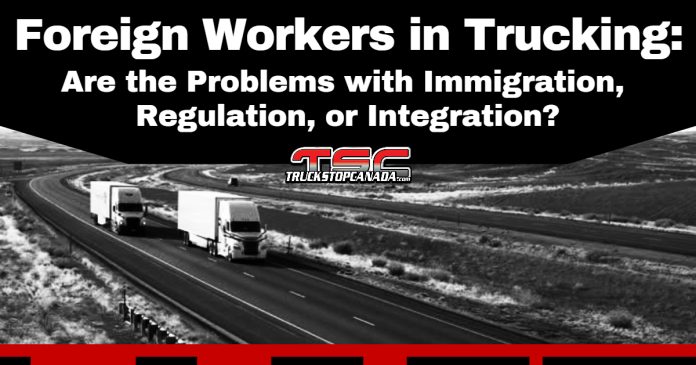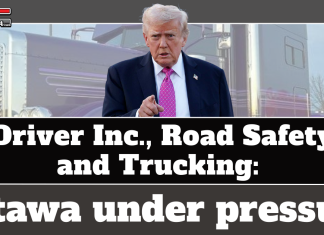In recent years, a series of accidents on Canadian roads has fueled growing concern. Foreign-born truck drivers are sometimes operating vehicles with minimal—or even no—formal training.
While immigration sparks debate worldwide, the presence of foreign workers in the trucking sector here raises a different question: the shortcomings of a regulatory system that allows such situations to occur.
An Urgent Need for Labor
For years, the trucking industry has been plagued by a severe labor shortage, coupled with persistent challenges in retaining drivers. Retirements, difficult working conditions, and low job attractiveness have steadily reduced the local talent pool. To fill the gap, companies have turned to the Temporary Foreign Worker Program (TFWP) or to international students who, upon arriving in Canada, have shifted into trucking.
Many of these individuals never planned on becoming truck drivers. But with rising living costs, financial obligations to send money back home, and limits on the number of hours they could work under a student visa, trucking became a more lucrative option. For some, it was a pragmatic choice; for others, a reluctant compromise—seen as a shortcut to permanent residency. This mix of vulnerability, opportunism, and regulatory loopholes has created a complex reality.
Today, the market is slowing. Hiring is down, layoffs are up, and experienced drivers are struggling to find work, while low-cost labor continues to rise. The emergency-driven model that brought these workers in was never truly regulated.
A Model Built Without a Foundation
Some private driving schools offer accelerated programs focused more on getting drivers licensed than on building real skills. In Ontario, the situation is compounded by the fact that DriveTest no longer faces a competitive bidding process. Its contracts are automatically renewed, raising questions about transparency and oversight.
A CBC Marketplace investigation last year revealed that some students had passed their road test without ever having driven a truck before. Some schools close or relocate to avoid audits, yet continue training—sometimes fraudulently.
Foreign drivers themselves have reported training and working conditions they describe as inadequate. Some say they were sent out alone with no mentoring and no knowledge of Canadian regulations; others claim they were threatened with loss of status if they refused to drive in extremely unsafe conditions. These accounts are well documented.
There are also reports of confiscated passports, abusive contracts, and exorbitant fees for so-called “guaranteed placements.” Such practices, verging on exploitation, thrive in an environment of limited information and fear of retaliation.
Difficult and Deficient Integration
Adapting to the job means more than just driving. Newcomers must learn industry-specific terminology, unwritten rules, and a completely different workplace culture. For many, the Canadian winter is a shock: icy roads, reduced visibility, freezing rain. Yet, nothing in current law prevents a new driver—who may have never driven in winter—from being sent out alone in such conditions.
Distracted driving, such as cell phone use behind the wheel, is not unique to foreign drivers. However, when combined with inexperience and a lack of familiarity with the territory, it becomes an added safety risk. Current training programs rarely address winter realities, cultural adaptation, isolation, tax regulations, or the financial pressures that can push drivers into unsafe decisions.
On social media, the term “illegal truckers” is sometimes used to describe certain drivers, although this label is not legally accurate in many cases. Still, in proven instances of fraud or behavior that endangers public safety, strong sanctions should be enforced.
Punishing offenders without addressing the systemic failures that allowed these situations to happen is treating the symptom, not the cause.
The Question of Racism
The debate becomes even more complicated when racism enters the picture. The use of derogatory terms such as “flip-flops” to describe drivers is not a legitimate critique—it is discriminatory language that shifts the conversation away from its original purpose.
This issue can even spill into the justice system. Fearing accusations of discrimination, some judicial decisions have been adjusted—leading to different sentences for foreign workers, either to avoid deportation or in recognition of systemic racism.
In reality, the picture is more nuanced. Among incorporated drivers, some demonstrate exemplary professionalism, just as many foreign workers do. Conversely, both groups also include individuals engaged in unsafe practices or fraudulent schemes.
This raises a fundamental question: Is the problem really with the individual—or with a system that applies its rules unevenly?
When discussions are consistently reduced to accusations of racism, the core issues get lost, and the debate weakens. For many in the industry—including trucking groups in both French and English—it is urgent to bring the conversation back to its real foundations if progress is to be made.
A Grey-Area Reality
The use of foreign workers is not, in itself, the root of the problem. The real issues lie in integration—often carried out without sufficient oversight. Holding a driver’s license does not guarantee mastery of the skills required to be a professional truck driver.
A complete, rigorous training program, ongoing supervision, on-the-road mentoring, and zero tolerance for fraud—whether from drivers, companies, training centers, or brokers sourcing low-cost labor—are essential. Integration must also include support tailored to cultural, linguistic, and social realities, as well as protection against isolation and exploitation.
The reality is more complex than simply blaming foreign drivers. The industry has needed—and still needs—them. It welcomed them, but has not always given them the tools, supervision, and information required to do the job properly. The result: vulnerable drivers, sometimes dangerous through no fault of their own, and a tense social climate around their presence.
The solution? Perhaps a full reform—mandatory supervised training, stronger oversight, and equal enforcement of rules and sanctions for all—would be a starting point.
Read More :
















Very well written piece, points to the problems, not of immigrant drivers, but of training/proper Gov’t over-sight for credentialing.
This is the same issue in the U.S and Mexico. Truckers need to organize, fight for good working conditions and standards in our Industry!!! Across our 3 Countries!!!
Well said. By doing so, all the industry will benefit.